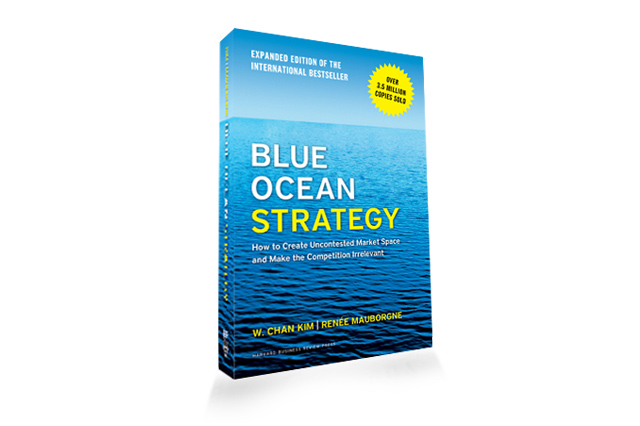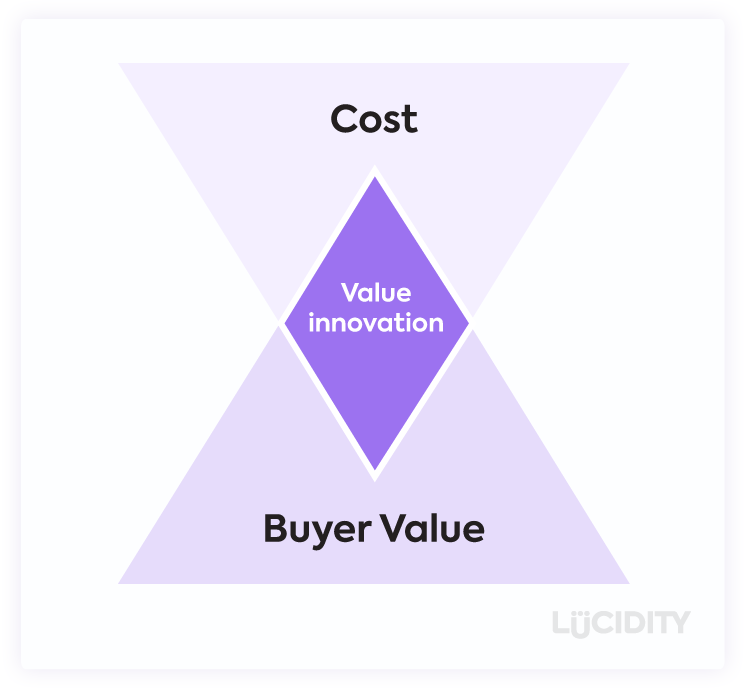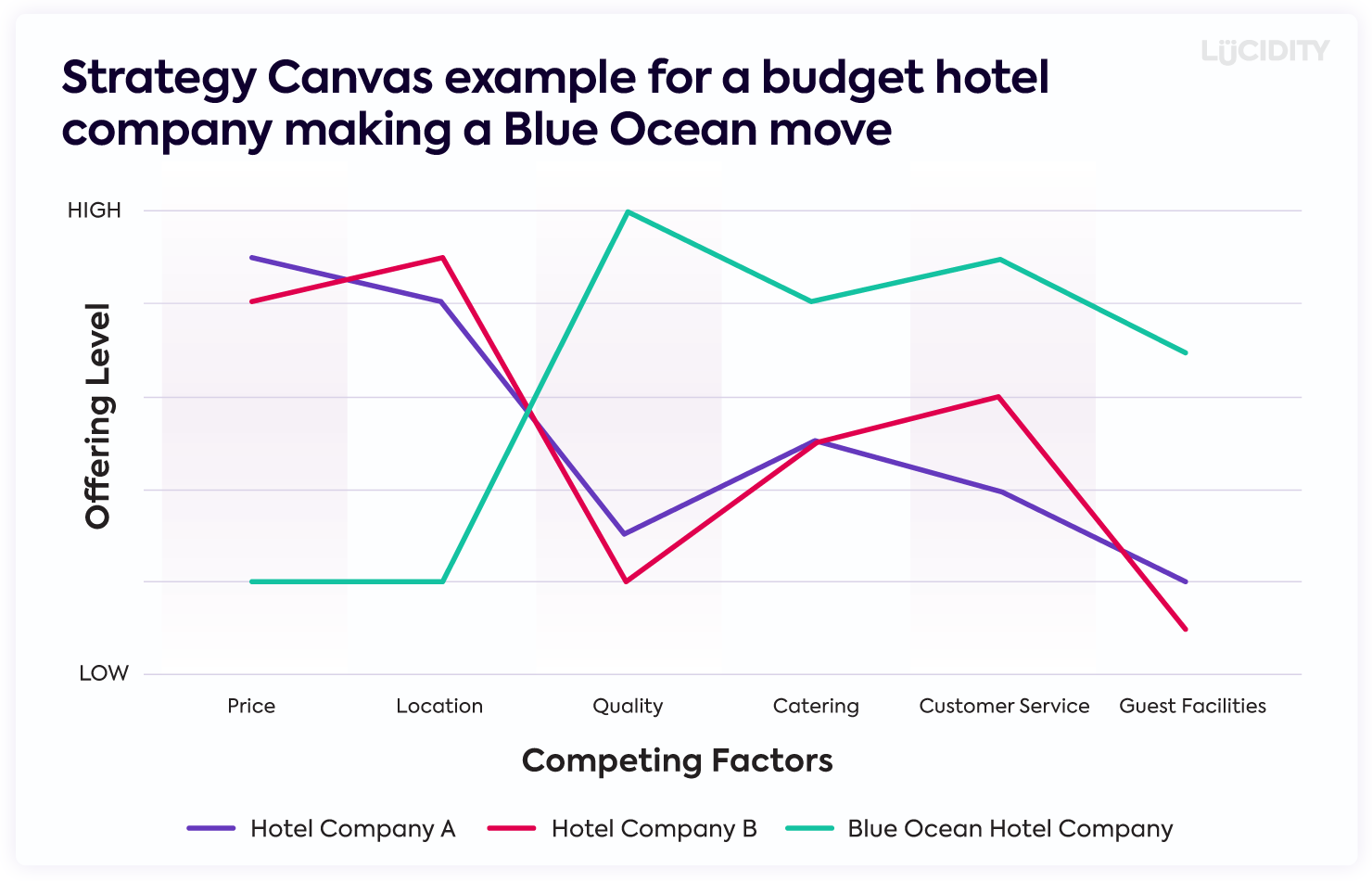Blue Ocean Strategy is one of the best-selling and most important books on business strategy ever written. But what is it all about and what are the important lessons we can learn as business leaders looking to forge our own strategic direction and succeed?
Let’s take a look…
Would you rather operate in a highly competitive market or in one free from competition? That’s the question posed by the book Blue Ocean Strategy. It is about getting “out of the red ocean of bloody competition and into a blue ocean of uncontested market space characterised by new demand and strong profitable growth”. The strategy advocated by the authors W. Chan Kim and Renée Mauborgne is underlined by descriptions of the success stories of many companies who have implemented blue ocean strategies.
Many of the industries we know today started out as blue oceans – automotive, electronics, computers, aviation, shipping containers, petrochemicals, biotechnology, smartphones, mobile banking etc. In time, competition emerged, but firms still managed to find new blue ocean opportunities in these markets.
The authors make five key points:
- Competition should not occupy the centre of strategic thinking
- Industry structure is not given; it can be shaped
- Strategic creativity can be unlocked systematically
- Execution can be built into strategy
- There is a step-by-step model for creating strategy
A Blue Ocean Strategy is about growing demand and breaking away from competition. The paradox is that the only way to beat the competition is to stop trying to beat the competition. Successful blue ocean companies follow a different strategic logic that the authors call Value Innovation.
Value Innovation
Instead of focusing on overcoming the competition, with Value Innovation, you “focus on making the competition irrelevant by creating a leap in value for buyers and for your company”, thereby opening up new and ‘uncontested’ market space. You should place the same emphasis on value and on innovation (not necessarily technology innovation), and align innovation with utility, price, and cost positions.
Value Innovation is about saving costs by eliminating and reducing the factors an industry competes on while increasing buyer value by raising and/or creating factors the industry has never offered.
8 Guiding Principles of Blue Ocean Strategy
The authors set out eight guiding principles of Blue Ocean Strategy:
Formulation principles:
- Reconstruct market boundaries
- Focus on the big picture, not the numbers
- Reach beyond existing demand
- Get the strategic sequence right
Execution principles:
- Overcome key organisational hurdles
- Build execution into strategy
- Align the value, profit, and people propositions
- Renew blue oceans
We’ll come back to each of these principles in detail, after first looking at the different models and frameworks outlined in Blue Ocean Strategy.
The book maps out a number of tools and frameworks to help you analyse the market and build out your Blue Ocean Strategy.
The Strategy Canvas & The Value Curve
The Strategy Canvas tool allows you to analyse the current state of play in the known market space and move your focus onto blue ocean opportunities. Its basic component is the Value Curve, a simple graphic view of a company’s relative performance across the factors determining competition in its industry.
To create a Strategy Canvas, you take the factors that the industry competes on and rank each one high or low in terms of value they offer the buyer. A high score means that a company offers more, and hence invests more, in that factor.
By plotting the performance of a company against the factors, you arrive at a value curve for the company. If you do that across an industry, you will find broad convergence of the value curves. By examining the industry value curve, you may be able to identify factors where you can cut costs or offer more value, creating your own blue ocean value curve. The authors use the example of Southwest Airlines whose sanalysis of the US airline industry found the relevant factors were price, seating choices, hub connectivity, lounges, meals, friendly service, speed, frequent point to point departures.
Here’s an example to help illustrate how the canvas works. In this example we’ve mapped out the competing factors for the budget hotel industry and plotted the value curve for a couple of players in this market.
A Blue Ocean strategic move in this example, might follow a curve that peaks extremely highly for quality and lower for price. It might curve upwards for catering and customer service and not so highly for location, for example.
Four Actions Framework
Once you have created your Strategy Canvas, the authors’ Four Actions Framework gives you four key questions to challenge your industry’s business model and build an action plan:
- Which factors can be eliminated?
- Which factors can be reduced?
- Which factors should be created?
- Which factors should be raised well above the industry’s standard?
The first two address your cost structure; the second two show how to increase buyer value and create new demand.
The Eliminate-Reduce-Raise-Create Grid
The authors’ third tool is the Eliminate-Reduce-Raise-Create grid. This pushes companies to ask all four questions but also to act on all four to create a new Value Curve. Mapped out as a four box quadrant, with one box each for Eliminate, Reduce, Raise and Create respectively, leaders should fill out each box with the tangible things they are going to action as a business.
Let us now return to the eight guiding principles of Blue Ocean Strategy.
Reconstruct market boundaries
Break out of the accepted boundaries that define how you compete; look outside. The authors describe a Six Paths Framework to creating blue ocean opportunities. The framework is intended to help businesses look beyond their market and their traditional competitors and customers and expand their realm of consideration.
Six Paths Framework
The six different things to examine when looking for your Blue Ocean Strategy are:
- Alterative industries for lessons you can learn
- Strategic groups within industries for clusters of companies following a similar strategy
- The chain of buyers, formal and informal, who are involved in purchasing decisions
- Complementary products or services which may influence demand for your products and services
- Functional and emotional appeal to buyers – is there a way to add functional or emotional appeal?
- Time – what are the trends that will affect your business?
Focus on the big picture, not the numbers
Draw your Strategy Canvas. Go out and see how customers use your products/services. Also go after non-customers, who might well be waiting for what you can offer in the blue ocean. Use the Eliminate-Reduce-Raise-Create grid. Communicate your strategy in a way that can be understood by every employee. Do so in a visual way. The authors advocate use of a Pioneer-Migrator-Settler map.
Reach beyond existing demand
Look to non-customers. Build on things that are common in what buyers value. The authors describe three tiers of non-customers:
- “soon to be” customers, on the edge of your market waiting to jump ship
- “refusing’ non-customers who consciously choose against your market
- “unexplored” non-customers who are in markets far away from yours
Non-customers tend to offer more insight into how to unlock and grow a blue ocean than do relatively content existing customers. We also saw this with disruptive innovation, where companies grew by offering products to unserved or underserved customers of established firms and, in time, grew to supersede the establishment.
Get the strategic sequence right
The recommended sequence leading to a commercially viable blue ocean idea is buyer-utility/price/cost/adoption. In each case the book gives a key question to ask. If you don’t get a Yes answer, rethink. Again, the book gives guidance and tools for examining each aspect.
As regards pricing, the price needs to attract customers but also keep them. The book helps you to identify a “price corridor” that your price should fall within. You then need to move to target costing, instead of strategic pricing. This is about price-minus costing, not cost-plus pricing. You have three levers – you can streamline operations and introduce cost innovations; you can partner to leverage other companies’ expertise and economies of scale, or you can change the pricing model of the industry, possibly by introducing a new business model, such as freemium, multi-sided platforms or leasing instead of selling.
The final part of the sequence, adoption, is about overcoming resistance by defusing the fears of employees, business partners or the general public.
Overcome key organizational hurdles
This is about executing your Blue Ocean Strategy. You need to get employees to understand the need for a shift in strategy, you may need to cope with limited resources, you need to motivate your people and counter internal politics. Tipping Point leadership enables you to overcome these barriers, by focusing on the extremes. Focus on identifying and then taking advantage of the things that exercise a disproportionate influence on performance. Show your management the worst of the organization, get them to meet with dissatisfied customers and understand the changes needed. To jump the resource barrier, identify the hot spots where resources can make the most difference and move people in from cold spots, which are probably over-resourced.
To jump the motivational hurdle, concentrate on the key influencers in your organization, the natural leaders, who are well respected. Break the organization into bite sized chunks to get it to change itself – small chunks that everyone can relate. This will make the organization actionable at all levels. You also need to neutralize politics – add a trusted advisor to your inner team, one who understands the organization’s politics and how to isolate opposition.
Build execution into strategy
Create a culture of trust and commitment that motivates people to execute the agreed strategy. There are three principles, mapped out by the authors:
- Engagement – involve people in strategic decisions by asking their input and allowing them to dabate the merits of one another’s ideas and assumptions
- Explanation – everyone should understand the rationale behind the final decisions
- Expectation – clarify the new rules of the game
You also need to apply these principles with external stakeholders.
Align the value, profit, and people propositions
These three propositions are essential to the success of the strategy and must be mutually reinforcing. The authors use the example of Comic Relief to show how the organization achieved strategic alignment between their value, profit, and people propositions and created a blue ocean within the fund-raising charity space.
Renew blue oceans
You need to institutionalize Blue Ocean Strategy as a repeatable process. If you do the strategy well, you may not face credible competition for many years, but eventually your ocean will turn red. When your Value Curve starts to converge with competition, it is time to go looking for another blue ocean.
The authors conclude the book with discussion of ten common red ocean traps that work against the creation of blue oceans. There is also an appendix that discusses the history of three American industries and how blue oceans were created and renewed in these industries – automobiles, computers and cinemas.
If you’re serious about strategy it’s well worth having a copy of Blue Ocean Strategy on your bookshelf.
Talk to us about building your strategy
If you're formulating or executing your strategy, let us show you how our strategy software can get you there faster.














